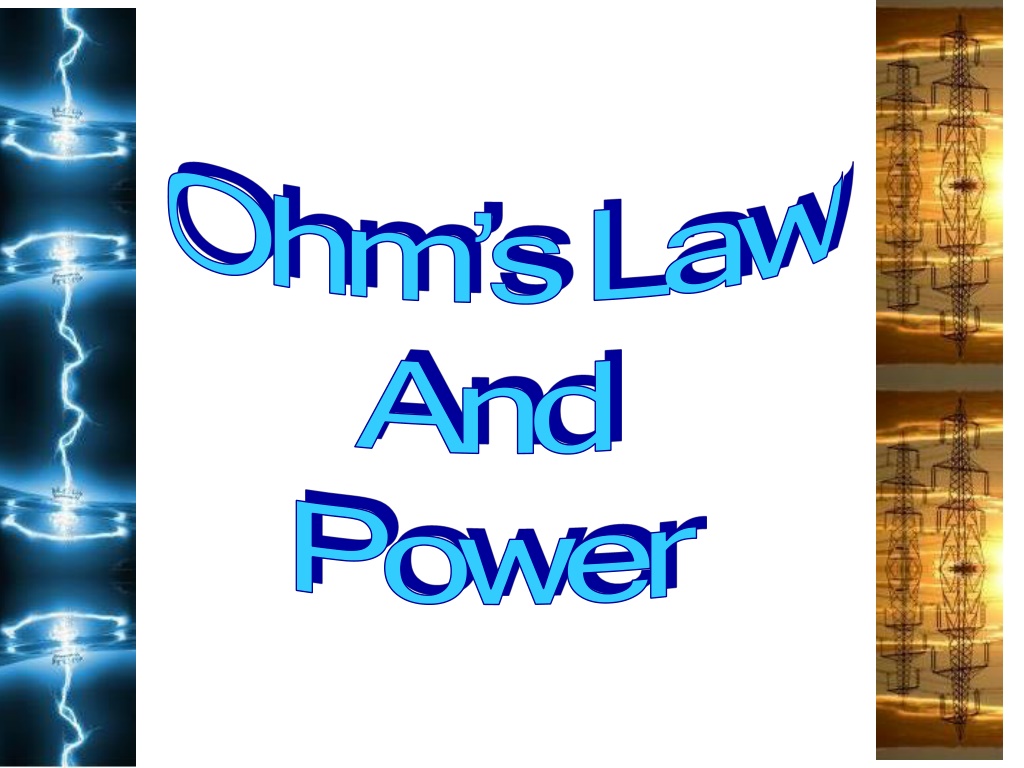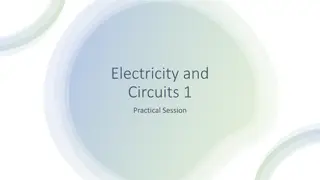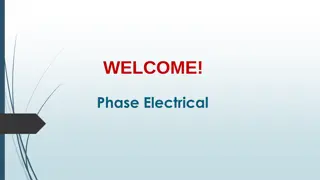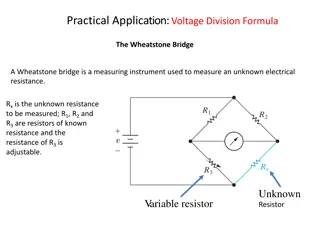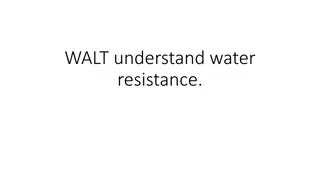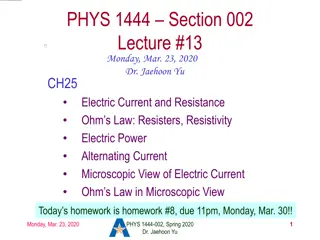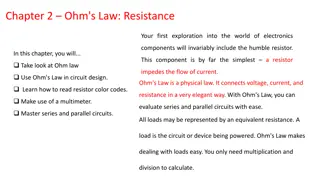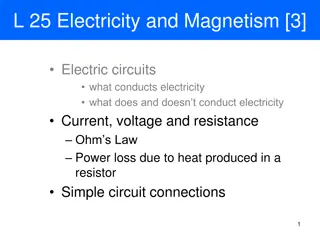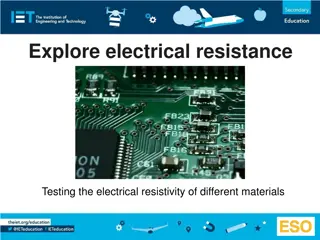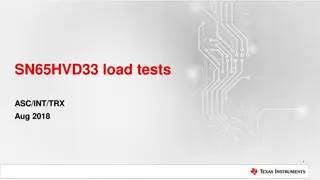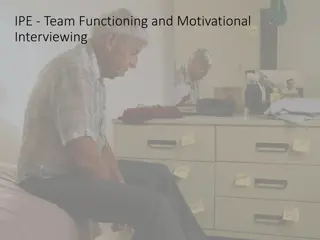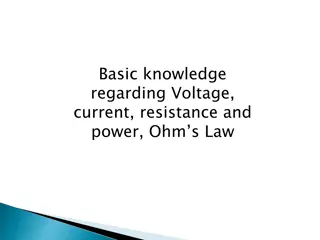Understanding Ohm's Law and Electrical Resistance
Explore the principles of Ohm's Law and electrical resistance, understanding how resistance affects electron flow in circuits, the relationship between voltage drop and resistance, and practical examples of applying Ohm's Law in circuit calculations. Discover the impact of resistance in wires and how resistors influence circuit behavior. Test your knowledge with a check for understanding on factors influencing current flow in circuits.
Download Presentation

Please find below an Image/Link to download the presentation.
The content on the website is provided AS IS for your information and personal use only. It may not be sold, licensed, or shared on other websites without obtaining consent from the author. Download presentation by click this link. If you encounter any issues during the download, it is possible that the publisher has removed the file from their server.
E N D
Presentation Transcript
Electrical resistance (symbol R) Electrons flow due to potential difference. If the potential difference is removed, then electrons stop flowing. As electrons move, they bump into other atoms, this slows them down and impedes their motion. path atoms (actually positive ions) free electron . Resistance (R) is a measure of the degree to which an object impedes the flow of current. Resistance is measured in Ohms ( )
Resistance Across a Circuit How do resistors affect circuits? The energy of electricity comes from the movement of the electrons. So, by slowing down the electrons, resistance causes the charges to lose energy / electric potential. Most of the loss of potential comes from the circuit elements, such as lights and motors (often just called resistors) which are using the kinetic energy of the electrons to do something (make light, turn a motor, etc.). We call this loss of electrical potential voltage drop (or potential drop).
WIRE_VACUUM_SEAL Resistance in Wires Most of the time, wires are designed to have as little resistance as possible, mainly by making them short, thick, and out of a good conductor, such as copper. So, in most cases, we can completely ignore the resistance of the wires within our circuits. But, in some cases, the wire is designed to have high resistance (and high loss of energy to heat), usually by making the wire very very long
What is the relationship between resistance and voltage drop? Introducing . Ohm s Law V = I R V is potential difference across a resistor I is current R is resistance
Examples If a 3 volt flashlight bulb has a resistance of 9 ohms, how much current will it draw? I = V / R = 3 V / 9 = 1/3 Amps If a light bulb draws 2 A of current when connected to a 120 volt circuit, what is the resistance of the light bulb? R = V / I = 120 V / 2 A = 60
Check for Understanding Which of the following would cause the current in a circuit to decrease the most? 1) 2) 3) 4) Increased voltage and increased resistance Increased voltage and decreased resistance Decreased voltage and decreased resistance Decreased voltage and increased resistance
Check for Understanding If the resistance of a circuit were tripled, then the current through the circuit would be ____. 1. one-third as much 2. three times as much 3. unchanged 4. ... nonsense! There would be no way to make such a prediction.
Just for Fun Effects of electric current on the BODY- electric shock Current (A) can be felt Effect 0.001 painful 0.005 involuntary muscle contractions (spasms) 0.010 loss of muscle control 0.015 if through the heart, serious disruption; probably fatal if current lasts for more than 1 second 0.070
human body resistance varies: 100 ohms if soaked with salt water; moist skin - 1000 ohms; normal dry skin 100 000 ohms, extra dry skin 500 000 ohms. What would be the current in your body if you touch the terminals of a 12-V battery with dry hands? I = V/R = 12 V/100 000 = 0.000 12 A quite harmless But if your hands are moist and you touch 12 V battery, how much current would you draw? I = V/R = 12 V/1000 = 0.012 A a dangerous amount of current.
Electric Power What is power? Power = ???? ???? = ?????? ? ???? Unit: Js-1 = W ???? Electric power is the rate at which electric energy is converted into another form such as mechanical energy, heat, or light. What does a 60W light bulb mean? It converts electrical energy into light/heat energy at a rate of 60 J per second. If we play around with the electric potential energy equation, we can derive another form of the power equation that is more useful in circuits: P = VI
Electric Power We Do How much current is drawn by a 60 Watt light bulb connected to a 120 V power line? What is the resistance of the bulb?
Electric Power We Do How much current is drawn by a 60 Watt light bulb connected to a 120 V power line? P = 60 W = I V = I x 120 so I =0.5 A What is the resistance of the bulb? I = V/R R = V/I = 120 V/0.5 A R = 240
Electric Power You Do 1. Calculate the resistance and the current of a 1500-Watt electric hair dryer plugged into a US household outlet (120 V). 2. The sticker on a compact disc player says that it draws 288 mA of current when powered by a 9 Volt battery. What is the power (in Watts) of the CD player?
Electric Power You Do 1. Calculate the resistance and the current of a 1500-Watt electric hair dryer plugged into a US household outlet (120 V). I = P / V = (1500 W) / (120 V) I = 12.5 Amp R = V / I= (120 V) / (12.5 Amp) R = 9.6 2. The sticker on a compact disc player says that it draws 288 mA of current when powered by a 9 Volt battery. What is the power (in Watts) of the CD player? P = I V = (0.288 A) (9 V) P = 2.59 W
Paying for electricity You pay for electricity by the Kilowatt-hour (kWh). What is a kWh? Simply another unit for energy.
Paying for electricity You pay for electricity by the Kilowatt-hour (kWh). What is a kWh? Simply another unit for energy. Physicists measure energy in joules, but utility companies customarily charge energy in units of kilowatt-hours (kW h), where : Kilowatt-hour (kWh) = 1000 W x 3600 s 1W x 1s = 1J 1 kWh = 3.6 x 106 J
Paying for electricity You pay for electricity by the Kilowatt-hour (kWh). What is a kWh? Simply another unit for energy. Physicists measure energy in joules, but utility companies customarily charge energy in units of kilowatt-hours (kW h), where : Kilowatt-hour (kWh) = 1000 W x 3600 s 1W x 1s = 1J 1 kWh = 3.6 x 106 J At a rate of 14 cents per kWh, how much does it cost to keep a 100 W light bulb on for one day? energy (kWh) = power (kW) x time (h) energy (kWh) = 0.1 kW x 24 h = 2.4 kWh cost / day = 2.4 kWh x 14 cents/kWh = 33.6 for one month that amounts to $ 10.1.
Paying for electricity You do A 9V battery costs $1.25. If placed in a cd player that draws a 300 mA current, it will last for 32 hours. What is the price per kWhr? 9?(0.3?)(32 ????) 1000? = 0 .086 kWhr ?? $1.25/0.086 kWh = $14 /kWhr
